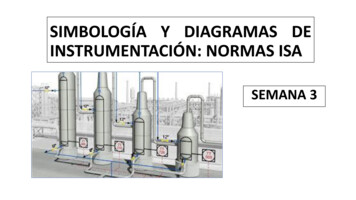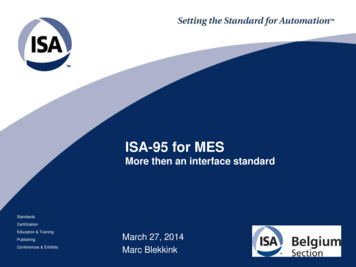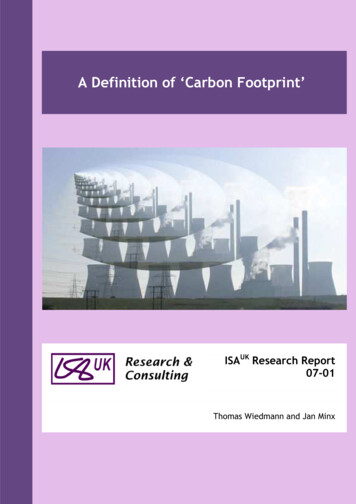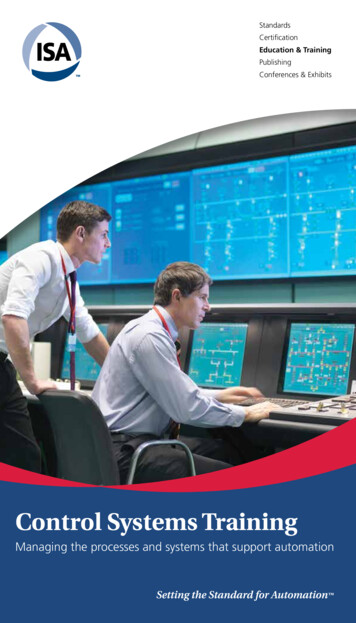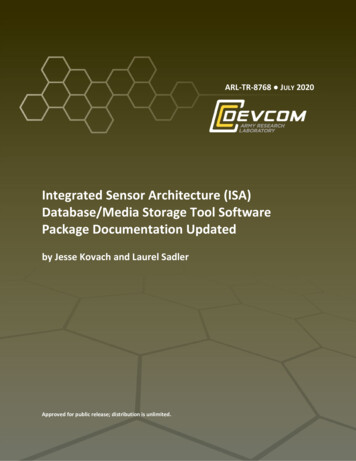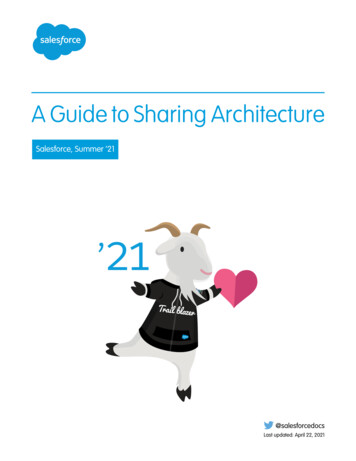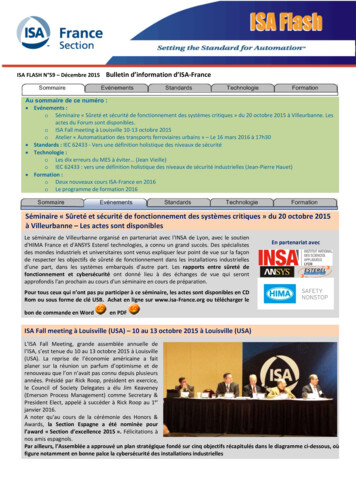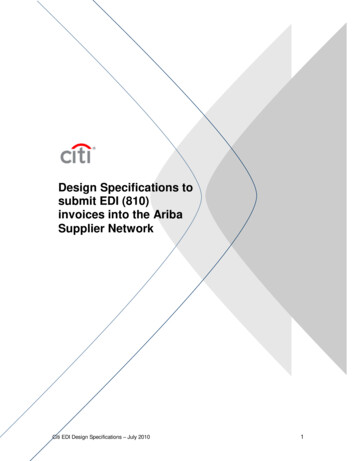
Transcription
ISA Access Control SpecificationENHANCE SHARED SITUATIONAL AWARENESSInformation Sharing Architecture (ISA)Access Control Specification (ACS)Supplement to the ISA Shared Situational Awareness (SSA)Requirements DocumentVersion 3.0aJune 2019https://www.us-cert.gov/essaISA Access Control Specification
ISA Access Control SpecificationRecord of ChangesVersionDateAuthor1.0Aug 28,2013ISAImplementationWorking Group1.1Feb 10,2014ESSA PortfolioManagementTeam2.0December16, 2014ESSA PortfolioManagementTeamChangesInitial publication. Editorial changes and clarifications Updated some values in Appendix A to match or deconflict withUS Agency values in IC EDH Deleted Supplemental Sensitivity Criteria and replaced it withSource Entity Added Resource Deletion Date and Time Added ECS in Logical Access Criteria/Groups Replaced ISA Participant with NCC (National CyberCenters) in Logical Access Criteria/Groups Added Appendices C & D to compare the ISA ACS and existingspecifications Limited the values of Dissemination Controls to those requestedby the ISA Participants Specified which CUI categories are needed by ISA Participants Limited the “User Status” resource attribute values so they mapdirectly to the “Entity Type” entity attribute Added derived ISA requirements Added Proprietary, Law Enforcement Sensitive (LES), and LESNOFORN to Dissemination Controls to match CAPCO Changed Public Release Dissemination (True/False) to a requiredfield for unclassified resources 3.03.0aJune 27,2019Incorporated major updates to Resource Attributes based onthe creation of the ISA implementation of SD-EDH.Made minor changes to user attributes based on resourcechanges.Updated Use Cases in Section 5.Updated Organizational values in Appendix A.ESSA PortfolioManagementTeam DHS CISA/CSDUpdated CISAUSES on page 25 from: “The cybersecurity purposesMade changes based on the CybersecurityInformation Sharing Act of 2015Made changes in support of Automated Information Sharing (AIS)including adding Further Sharing and adding additional valuesallowed in the Cybersecurity Information Sharing Act of 2015(Reference 36).” To: “Indicates that the CTI must be grantedthe protections spelled out in the Cybersecurity InformationSharing Act of 2015 (Reference 36), including that thegovernment will only use the information for thecybersecurity purposes spelled out in that document.”ISA Access Control Specification
ISA Access Control SpecificationThis page intentionally left blank.ISA Access Control Specificationiv
ISA Access Control SpecificationExecutive SummaryThe vision for the Information Sharing Architecture (ISA) in support of the Enhance Shared SituationalAwareness (ESSA) initiative is to create real-time cyber shared situational awareness based onmachineto-machine information sharing as described by the ISA Shared Situational Awareness (SSA)Requirements. This cyber shared situational awareness supports both individual and integratedresponse actions to prevent malicious cyber activity and, when that fails, to protect and recover quicklyfrom malicious cyber actions. At the core of that vision is automated, machine-to-machine informationsharing across the cybersecurity community. The foundational work done by ESSA to establish a FederalCybersecurity Information Sharing Community and the ISA provides an existing capability to support therequirements outlined in the Cybersecurity Information Sharing Act of 2015.Information sharing across a Federal Cybersecurity Information Sharing Community requires a capabilityto protect and allow access to information in accordance with applicable information sharingagreements, policies, and laws. Capabilities must be put in place to ensure that information is onlyshared with those that should be allowed to see it, as determined by the information owner. As thequantity of shared information, the number of information types, and the number of participants’increase, the means of enforcing policies on information sharing and controlling access must beautomated and scalable to meet mission needs. The Federal Cybersecurity Centers and Stakeholders inthe ISA collaborated on a single, flexible approach to machine-based access control that builds uponadvancements made by individual communities (e.g. Intelligence Community, Defense, LawEnforcement, etc.) and expands to meet the needs of the broad, cross-organizational cybersecuritycommunity.This Access Control Specification (ACS) document, the result of that collaboration, specifies the dataelements required to implement automated access control systems based on the relevant policiesgoverning sharing between participants. Initially developed to support information sharing by theEnhance Shared Situational Awareness (ESSA) initiative across the Federal Cyber Centers, the ACSspecifies a common set of elements for tagging information and related common attributes that indicatecharacteristics of a person or system that allow automated decisions to be made regarding informationISA Access Control Specificationv
ISA Access Control Specificationsharing. The ACS provides a structure to support expansion of the ESSA Community to include allFederal Entities in support of the Cybersecurity Information Sharing Act of 2015.This page intentionally left blank.ISA Access Control Specificationvi
ISA Access Control SpecificationTable of Contents1 Introduction . 41.1 ISA Background . 51.2 Access Control Attributes . 61.3 Relationship to Other Access Control Efforts . 71.4 Scope of Document . 81.5 Definitions and Use of Terms . 91.5.1 Entities . 91.5.2 Entity Attributes . 91.5.3 Policies and policy rules . 91.5.4 Resource . 91.6 Attribute Dependencies . 92 ISA Resource Attributes . 102.1 Resource Accounting Group . 192.1.1 Resource Identifier. 192.1.2 Resource Creation Date and Time . 192.1.3 Responsible Entity. 202.1.3.1 Custodian . 202.1.3.2 Originator . 212.1.4 Authorization Reference . 212.2 Control Policy Group . 222.2.1 Policy Reference. 222.2.2 Policy . 232.2.2.1 Access Privilege . 242.2.2.2 Further Sharing . 262.2.2.3 Original Classification . 262.2.2.4 Derivative Classification . 272.2.2.5 Declassification . 272.2.2.6 Resource Disposition . 272.2.2.7 Public Release . 282.2.3 Control Set . 282.2.3.1 Classification . 292.2.3.2 Sensitive Compartmented Information Control System . 302.2.3.3 Logical Authority Category . 302.2.3.4 Formal Determination . 312.2.3.5 Caveat. 32ISA Access Control Specification1
ISA Access Control Specification2.2.3.6 Sensitivity . 332.2.3.7 Shareability. 352.2.3.8 Affiliation . 363 ISA Entity Attributes . 383.1 Admin Organization . 393.2 Authority Category . 403.3 Access Groups . 403.4 ATO Status. 413.5 Authorized IC Person . 423.6 Clearance . 433.7 Country of Affiliation. 433.8 Digital Identifier . 443.9 Duty Organization . 453.10 Entity Type . 453.11 Fine Access Controls . 463.12 Is IC Member . 473.13 Life Cycle Status . 474 ISA Access Control Policy Rules. 484.1 Access Control Policy Rule Limitations . 495 ISA Access Control Use Cases. 505.1 Use Case 1: Access Granted to Cybersecurity Data . 505.2 Use Case 2: Access Privilege . 515.3 Use Case 3: PUBREL and Portion Marking . 535.4 Use Case 4: Analytic NPE. 545.5 Use Case 5: Access Denied to Law Enforcement Data. 556 Open Issues . 577 Conclusion . 57References . 59Acronyms . 61Glossary . 63Appendix A: List of Organizations . 64Appendix B: Summary of Derived ISA Requirements . 69Appendix C: Deltas between ISA ACS Entity Attributes and UIAS/EIAS/GFIPM . 71Appendix D: Deltas between ISA ACS Resource Attributes and IC Security Marking Encodings . 72Appendix E: Access Control Rule Set Example. 77List of FiguresISA Access Control Specification2
ISA Access Control SpecificationFigure 1: Overview of Access Control . 4Figure 2: Use of Attributes in Authorization Component of Access Control . 7Figure 3: Organization of Resource Attributes . 12Figure 4: Substitution Groups for the Policy Attribute . 24Figure 5: Data-Oriented and User-Oriented Attributes in the Control Set . 29Figure 6: Affiliation . 37List of TablesTable 1-1: Attribute Dependencies . 10Table 2-1: Summary of ISA Resource Attributes . 14Table 3-1: Summary of ISA Entity Attributes . 40Table 4-1: Relationship between ISA Resource Attributes and ISA Entity Attributes . 50Table 5-1: Use Case One – Access Granted to Cybersecurity Data . 52Table 5-2: Use Case Two – AccessPrivilege . 53Table 5-3: Use Case Three – PUBREL and Portion Marking . 55Table 5-4: Use Case Four – Analytic NPE . 56Table 5-5: Use Case Five – Access to Law Enforcement Data Denied . 57Table C-1: Entity Attribute Mappings . 72Table D-1: Resource Attribute Mappings. 74ISA Access Control Specification3
ISA Access Control Specification1 IntroductionThis Information Sharing Architecture (ISA) Access Control Specification (ACS) document specifies thedata elements required to implement access control mechanisms for exchanging cyber informationacross the community that has adopted the specification. The ACS is prescribed for Federal Entities thathave signed the Enhance Shared Situational Awareness (ESSA) Multilateral Information SharingAgreement, referred to as the ESSA Community. As the requirements of the Cybersecurity InformationSharing Act of 2015 are implemented, the ESSA Community will expand with additional signatories tothe MISA to include additional Federal Entities. Because the ESSA Information Sharing Participantsoperate within all three classification domains (Top Secret, Secret, and Unclassified), the resourcemarkings (data tags) and entity attributes are specified on all three domains in order to facilitate crossdomain use of the information. Using a common set of resource markings and entity attributes and acommon approach to access control enables integration and potential software reuse in differentorganizations.This ISA ACS specifies resource markings and user entity attributes to support a collection of activitiesthat include an initial access decision and also includes the necessary controls to inform subsequent orderivative activities, such as usage and further dissemination restrictions. Figure 1 illustrates the basicsteps in making the initial access control decisions based on access rules that reside at each ESSAInformation Sharing Participant (or their parent organization if the ESSA Information Sharing Participantis using their organization’s enterprise services). Authentication – The process of verifying with a trusted identity provider the identity claimed byor assumed of an entity, such as a user, process, or device (i.e., check that I am who I say I am)Authorization – The process of verifying the access privileges granted to an authenticated user,program, or process, or the act of granting those privileges (i.e., check what I am allowed to see)Figure 1: Overview of Access ControlAttribute-Based Access Control (ABAC) was selected by the ESSA Information Sharing Participants as themost appropriate approach to ISA authorization. ABAC is based on attributes associated with and aboutsubjects, objects, targets, initiators, resources, or the environment. An access control rule set definesthe combination of attributes under which an access may take place. Because the ISA operates across aISA Access Control Specification4
ISA Access Control Specificationfederation of organizations within the Federal government, there is no central authority to define roles,policies, or threat levels required for other approaches to authorization such as Role-Based AccessControl (RBAC), Policy-Based Access Control (PBAC), or Risk Adaptable Access Control (RAdAC).ABAC provides the resource owners the most flexible level of control for making access decisions.Under ABAC, access control policies can be created and managed without direct reference to potentiallynumerous users and resources, and users and resources can be provisioned without reference to accesscontrol policy. NIST Special Publication 800-162 “Guide to Attribute Based Access Control (ABAC)Definition and Considerations” provides additional information on establishing ABAC. (Reference 1)As shown in Figure 1, authentication is a pre-requisite for authorization. Authentication is outside thescope of this document. Assuming an implemented digital identity management system is in place andthat authentication has occurred, there are three major components that enable the authorizationcomponent of ISA access control (i.e. ABAC): Resource Attributes (often called data tags) assigned to information resourcesEntity attributes assigned to people (or machines/non-person-entities) describing theirindividual privileges with regard to information accessPolicies (or rules) that marry up the above two itemsA common example of these components is classification/security clearance. A data resource has aclassification. A person has a security clearance. The policy is that the person must have the sameclearance level (or higher) as the classification of the data in order to see it. If there were only this oneattribute of access control then the system would determine the data resource’s classification and theindividual’s security clearance then apply the policy to determine if access is permitted. In cyberinformation exchange, there are a greater number of attributes of both data resources and people andmore complex access rules that must be addressed.Existing Policies as documented in sharing agreements, laws, Executive Orders, and other documents,specify the restrictions that ESSA Information Producers place on their data. These Policies includeExecutive Orders such as EO12333 and EO13556, the Multilateral Information Sharing Agreement(MISA), and others. The intent of the Access Control Specification (ACS) is to outline a set of resourceand entity attributes that will allow ESSA Information Sharing Participants to tag data and entities sothat, across the ISA, the sharing and usage restrictions identified in governing Policies can becommunicated and enforced in an automated fashion. This document defines the access controlattributes for people (or non-person-entities like machines and applications) and the attributes for dataelements or resources.1.1 ISA BackgroundThe Enhance Shared Situational Awareness (ESSA) initiative and the Information Sharing Architecture(ISA) originated with National Security Presidential Directive-54/Homeland Security PresidentialDirective-23 (NSPD-54/HSPD-23) that established a Comprehensive National Cybersecurity Initiative(CNCI). Of the 12 key cyber initiatives executed under CNCI, CNCI-5 directed the development ofenhanced Shared Situational Awareness (SSA) of the US cyber domain, supporting real time informationsharing for integrated operational action to improve the security of US Government assets and protectits critical infrastructure. At the end of FY13, some elements of the CNCI were sunset and otherstransitioned as their core mission continued forward and evolved. The core mission of CNCI-5, toISA Access Control Specification5
ISA Access Control Specificationenhance shared situational awareness, continued forward and has evolved to enable integratedoperational action under the name of Enhance Shared Situational Awareness (ESSA). To facilitate thiscontinuous and evolving mission, the ESSA Portfolio Management Team (PMT), co-led by DHS, FBI, andNSA, was tasked by the staff of the National Security Council (NSC) to work with the FederalCybersecurity Centers and other key stakeholders to implement the Information Sharing Architecture(ISA).The foundational work done by ESSA to establish a Federal Cybersecurity Information SharingCommunity and the Information Sharing Architecture (ISA) provides an existing capability to support therequirements outlined in the Cybersecurity Information Sharing Act of 2015.This document, the ISA Access Control Specification, is an element of the following collection of ISAproducts: ISA Framework (Reference 2) – Defined the original ISA Framework, which provides thecommon taxonomy and understanding of ISA Functions and Enduring Functional Exchanges(EFEs) among cybersecurity partners and stakeholdersISA Shared Situational Awareness (SSA) Requirements Document (Reference 3) – Translatesthe ISA framework into a set of enterprise requirements and community standards and includesthe maintained version of ISA Functions and EFEs o ISA Access Control Specification (ACS) – Asupplement to the ISA SSA Requirements Document that provides a common specification toinform automated access control decisions at all classification levelsISA Technical Implementation Plan (Reference 4) – Describes how and when the capabilitiesdefined in the ISA SSA Requirements Document will be built. The plan defines an incrementalapproach to ensure early mission benefit and support out-year flexibilityThe ISA is not an end in and of itself. Each ESSA Information Sharing Participant agrees on commonlyprovisioned standards and solutions and then implements, manages, and maintains the capabilities. AnESSA Information Sharing Participant is defined as an organization that performs any of the ISAFunctions defined in the ISA Framework and has accepted that information sharing, as defined by theISA, is a part of the organization’s cybersecurity mission. The capabilities described in the ISA aredependent upon machine processing of information and machine-level assurance that all policies andcontrols are applied in a trusted manner.1.2 Access Control AttributesThe ESSA Information Sharing Participants have agreed to use Attribute Based Access Control (ABAC) to:1. Ensure that information is only shared with those allowed to access it2. Allow access control decisions to be made by the owner of the information.As the quantity of shared information increases, the mechanism of controlling access must beautomated to be scalable. Attributes provide a consistent and automated approach to sharing thedetails about people, non-person entities (e.g., machine analytics), and information resources.Figure 2 is a refinement of Figure 1 that shows how pre-scripted access rules are applied to entity andresource attributes to make informed, automated access control decisions.ISA Access Control Specification6
ISA Access Control SpecificationFigure 2: Use of Attributes in Authorization Component of Access ControlAutomated access control depends on standardized attribute names and values among ESSAInformation Sharing Participants. This document defines two types of attributes: ISA Resource Attributes – Characteristics of the resource being requested (e.g., classification ofdata). Resources include data, applications, and services.ISA Entity Attributes – Characteristics about the person or non-person entity (NPE) requestingaccess. These characteristics are used to make authorization decisions (e.g., clearance level).The third major component of attribute based access control, the policies or rules, will be defined by theESSA Information Sharing Participants. The ISA ACS provides the tools to express these policiesconsistently; however the policies are not comprehensively defined in this document. The intendedrelationships between the resource markings and the entity attributes are outlined in Section 4.Appendix E also includes an example access control rule set that may serve as a starting point for policyapplication. However, different ABAC implementations will dictate the specific language required toencode the policies.Access control decisions can be logged to support subsequent auditing processes. For example, ifremediation steps must be taken in the case of an unauthorized release, the logged access controldecision and associated attributes assist with the remediation process.1.3 Relationship to Other Access Control EffortsThis ISA ACS was developed by aligning and building upon existing efforts to minimize impacts onimplemented, mature solutions while expanding to meet the needs of the cybersecurity community. Thedevelopment of the ISA ACS leveraged the following: Enterprise Data Header (EDH) o EDH Abstract Data Definition (ADD) (Reference 12) - Definesat an abstract level the minimum set of data elements that could apply generically to any type ofdata in order to meet enterprise data management requirements.ISA Access Control Specification7
ISA Access Control Specification o Smart Data EDH Data Encoding Specification (DES) (Reference 14) – Specifies encodingguidance for the common set of field
5 ISA Access Control Specification federation of organizations within the Federal government, there is no central authority to define roles, policies, or threat levels required for other approaches to authorization such as Role -Based Access Control (RBAC), Policy-Based Access Control (PBAC), or Risk Adap table Access Control (RAdAC).
